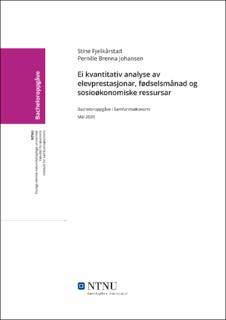| dc.contributor.advisor | Strøm, Bjarne | |
| dc.contributor.author | Fjellkårstad, Stine | |
| dc.contributor.author | Johansen, Pernille Brenna | |
| dc.date.accessioned | 2020-06-27T16:01:08Z | |
| dc.date.available | 2020-06-27T16:01:08Z | |
| dc.date.issued | 2020 | |
| dc.identifier.uri | https://hdl.handle.net/11250/2659730 | |
| dc.description.abstract | Vi har i oppgåva forsøkt å finne samanheng mellom lesepresentasjonar og innverknad frå relativ alder og sosioøkonomisk bakgrunn. Fyst forsøkte vi kartlegge tidlegare forsking, og såg der var betydeleg meir forsking og empiri på sosioøkonomisk bakgrunn enn fødselskvartal. Vi tydde til Coleman sin skuleproduktfunksjon, og der valte variablaar som kom innanfor elev-/og familiekarakteristika. Datasettet vi tok i bruk var PIRLS-undersøkinga frå 2001 som tok føre seg elevar på 4. og 5. årstrinn. For å finne effekt av relativ alder koda vi om fødselsmånad (birthm) til fødselskvartal og nytta utdanning hjå foreldra (par_edu), tilsettingsstatus foreldra (par_emp) og inntekta til familien (income) som mål på sosioøkonomisk bakgrunn.
Vi nytta minste kavdratars metode (OLS) og enkel linær-regresjon. Fyst tok vi føre oss kun fødselskvartal, og såg etter ein lineær samanheng mellom fødselskvartala (fødselsmåned1_3, fødselsmåned4_6, fødselsmåned7_9 og fødselsmåned10_12) og lesescore (read). Deretter tilla vi analysane fleire dummyvariablar kvar gong i følgande rekkefølge: par_emp_low, par_edu_high og income_high som gjev måla på tilsettingsstatusen, utdanninga og inntekta. Til slutt nytta vi interaksjonsledd med dei fødselskvartala og dei ulike familiekarakteristika kvar for seg i modell 5, 6 og 7. | |
| dc.description.abstract | In the assignment, we have tried to find a correlation between reading presentations and the influence of relative age and socio-economic background. First we tried to present earlier research, and saw that there was significantly more research and empirical data on socio-economic background than birth quarter. We pointed to Coleman's school production function, where there were variable variables that came within student / family characteristics. The data set we used was the 2001 PIRLS survey, which took pupils at the 4th and 5th grade. To find the effect of relative age, we code birth month for birth quarter and benefit education for parents (par_edu), parental employment status (par_emp) and income for the family (income) as a measure of socioeconomic background.
We used the least-squares method (OLS) and simple linear regression. First took us only birth quarter, and looked for a linear relationship between the birth quarters (birth month1_3, birth month4_6, birth month7_9 and birth month10_12) and reading score (read). We then allowed the analyzes to include several dummy variables in the following order: par_emp_low, par_edu_high and income_high which gave the measure of the employment status, education and income. Finally, we utilized interaction links with the birth quarters and the different family characteristics remaining in models 5, 6 and 7. | |
| dc.publisher | NTNU | |
| dc.title | Ei kvantitativ analyse av elevprestasjonar, fødselsmånad og sosioøkonomiske ressursar | |
| dc.type | Bachelor thesis | |
